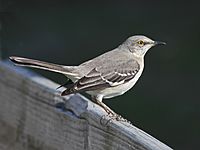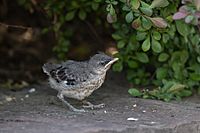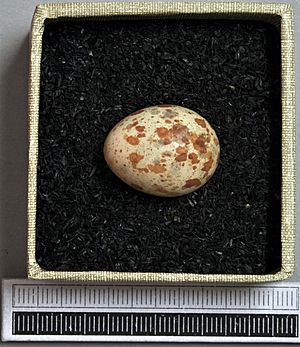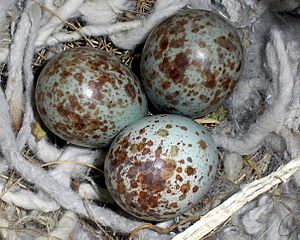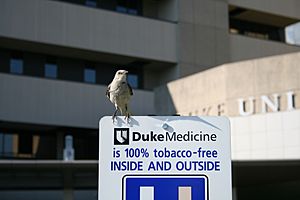Northern mockingbird facts for kids
Quick facts for kids Northern mockingbird |
|
|---|---|
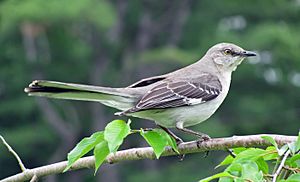 |
|
| An adult in New Hampshire | |
| Conservation status | |
| Scientific classification | |
| Genus: |
Mimus
|
| Species: |
polyglottos
|
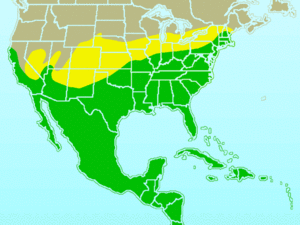 |
|
| Northern mockingbird range Breeding range Year-round range | |
| Synonyms | |
|
|
The northern mockingbird (Mimus polyglottos) is a famous bird in North America. It is known for its amazing ability to copy many different sounds! This bird has gray-brown feathers on its back and a lighter belly. When it flies, you can easily spot white patches on its wings and tail.
Mockingbirds are important in American culture. They are the official state bird for five states. You can find them in books, songs, and other parts of popular culture.
Contents
- What Do Northern Mockingbirds Look Like?
- Where Do Northern Mockingbirds Live?
- What Do Northern Mockingbirds Eat?
- Northern Mockingbird Behavior
- Northern Mockingbird Song and Calls
- Northern Mockingbird Reproduction and Life Cycle
- Predators and Threats to Mockingbirds
- Are Northern Mockingbirds Smart?
- How Mockingbirds Adapt to Cities
- Fun Facts About the Northern Mockingbird
- Northern Mockingbird Subspecies
- See also
What Do Northern Mockingbirds Look Like?
Northern Mockingbirds are medium-sized birds. They have long legs and tails. Their upper feathers are gray to brown. Their belly is usually white or light gray.
- Size: They are about 8 to 11 inches long. This includes their tail.
- Wingspan: Their wings can spread 12 to 15 inches wide.
- Weight: They weigh about 1.4 to 2.0 ounces. That's lighter than a tennis ball!
- Color: They are grayish-brown on top. Their underside is white or whitish-gray.
- Wings: Look for white bars on their wings.
- Tail: Their tail is black in the middle with white edges.
- Eyes: Their eyes are often light green-yellow or yellow.
- Beak: Their beak is black, but brownish at the base.
Baby mockingbirds look a bit different. They have streaks on their backs. They also have spots on their chests. Their eyes are gray or grayish-green. Male mockingbirds are usually a little bigger than females.
Where Do Northern Mockingbirds Live?
Northern Mockingbirds live across North America. You can find them from Canada all the way to Mexico. They also live in places like the Caribbean and Hawaii. These birds like open areas and woodlands. They also do well in cities and towns.
Sometimes, these birds even travel far! A few have been seen in Britain.
What Do Northern Mockingbirds Eat?
Northern Mockingbirds are omnivores. This means they eat both plants and animals. Their diet includes:
- Insects: They enjoy spiders, grasshoppers, and caterpillars.
- Fruits: They love berries and grapes.
- Seeds: They eat seeds from different plants.
- Small creatures: Sometimes, they even eat small lizards.
They find their food on the ground or in bushes. Mockingbirds sometimes do a funny dance. They spread their wings, showing off their white patches. Scientists are not sure why they do this. It might be to scare away predators. Or, it could be to catch insects!
Northern Mockingbird Behavior
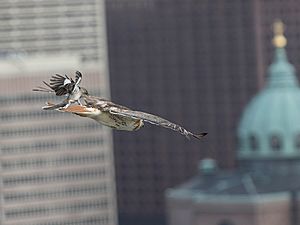
Northern Mockingbirds are famous for their amazing ability to copy sounds. They can mimic the songs of other birds. They can also copy animal sounds. Sometimes, they even imitate noises from machines!
- Mimicry: They are masters at copying sounds.
- Territorial: They strongly defend their territory and nests.
- Aggressive: They will chase away other birds and animals. This happens if they come too close.
Northern Mockingbird Song and Calls
Male mockingbirds sing a lot. They sing especially during the breeding season. They sing to attract females. They also sing to show off their territory. They have a huge collection of songs. They can sing up to 200 different types! Female mockingbirds sing too. But they do not sing as often or as loudly as the males.
They also have different calls. These calls are for different situations. For example, they have a call when they see a predator. They also have calls when they talk to their mate.
Northern Mockingbird Reproduction and Life Cycle
- Mating: Mockingbirds usually stay with the same partner for many years.
- Nesting: They build their nests in trees or bushes. Nests are usually 3 to 10 feet above the ground.
- Eggs: The female lays 3 to 5 light blue or greenish eggs. The eggs have spots. They can have two to four sets of babies each year.
- Incubation: The female sits on the eggs for about two weeks. This keeps them warm.
- Chicks: Baby mockingbirds are helpless when they hatch. Their parents must take care of them. The parents feed them and keep them warm. They also protect them until they can fly away.
Mockingbirds are very protective of their nests. They will even attack humans if they feel threatened! Male mockingbirds sing to attract females. The more songs a male knows, the more attractive he is. Females also check out the male's territory. They want to see if it is a good place to raise a family.
Predators and Threats to Mockingbirds
Northern Mockingbirds face several dangers.
- Predators: Their natural enemies include owls, hawks, snakes, cats, and crows.
- Weather: Harsh winter storms and dry seasons can be a threat.
- Other threats: Sometimes, they can get sick from parasites.
Are Northern Mockingbirds Smart?
Scientists have studied Northern Mockingbirds. They found that these birds are very smart. They can remember people who have threatened their nests. They will act defensively towards them. They can recognize individual humans. They remember who is a threat.
How Mockingbirds Adapt to Cities
Northern Mockingbirds are now more common in cities. They are found there more often than in the countryside. They have learned to live well in urban areas. They are good at finding food and shelter. They can even use artificial lights to find food at night.
Fun Facts About the Northern Mockingbird
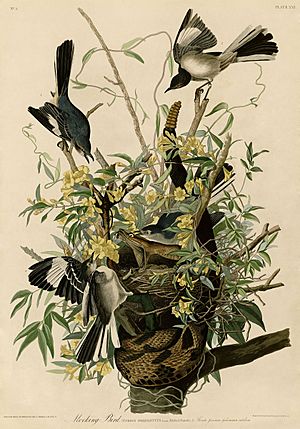
- Thomas Jefferson, a former U.S. President, had a pet mockingbird. Its name was "Dick."
- The scientist Carl Linnaeus first described this bird in 1758.
- The scientific name for the Northern Mockingbird is Mimus polyglottos. This means "many-tongued mimic."
- This bird is featured in the famous novel To Kill a Mockingbird by Harper Lee.
- The northern mockingbird is the state bird of Arkansas, Florida, Mississippi, Tennessee, and Texas. It used to be the state bird of South Carolina.
- Mockingbirds usually live up to 8 years in the wild. But birds kept in captivity can live up to 20 years!
Northern Mockingbird Subspecies
There are three main types, or subspecies, of the northern mockingbird.
- M. p. polyglottos: This type is found in eastern North America. It ranges from Nova Scotia to Nebraska. It goes as far south as Texas and Florida.
- M. p. leucopterus: This is the western mockingbird. It lives in western North America. You can find it from northwestern Nebraska to the Pacific Coast. It also lives south to Mexico and Socorro Island. This type is larger than M. p. polyglottos. It has a slightly shorter tail. Its upperparts are more buff and paler. Its underparts have a stronger buff color.
- M. p. orpheus: This type is found from the Bahamas to the Greater Antilles. It also lives in the Cayman and Virgin Islands. It is similar to M. p. polyglottos. However, it is smaller. It has a paler gray back. Its underparts have very little buff color.
See also
 In Spanish: Cenzontle común para niños
In Spanish: Cenzontle común para niños



